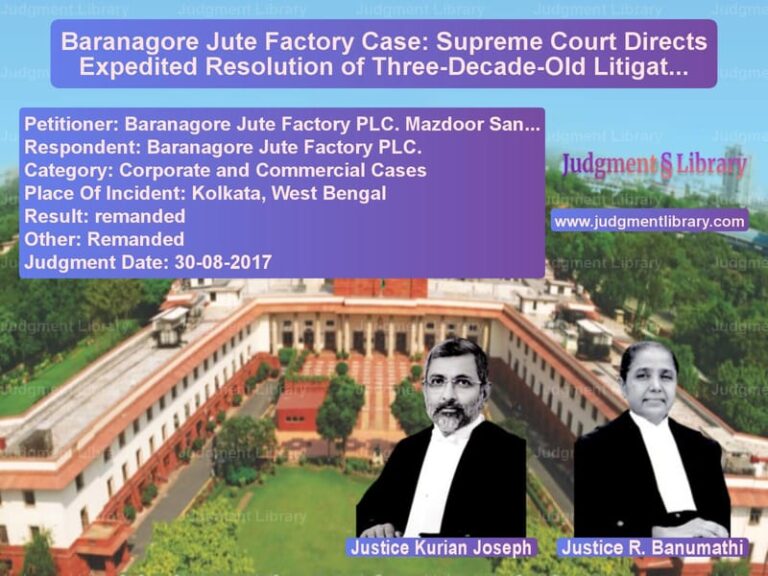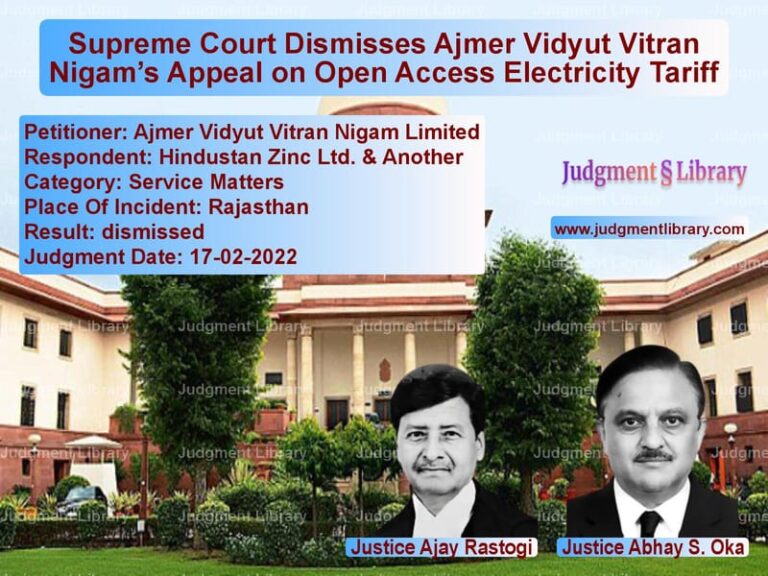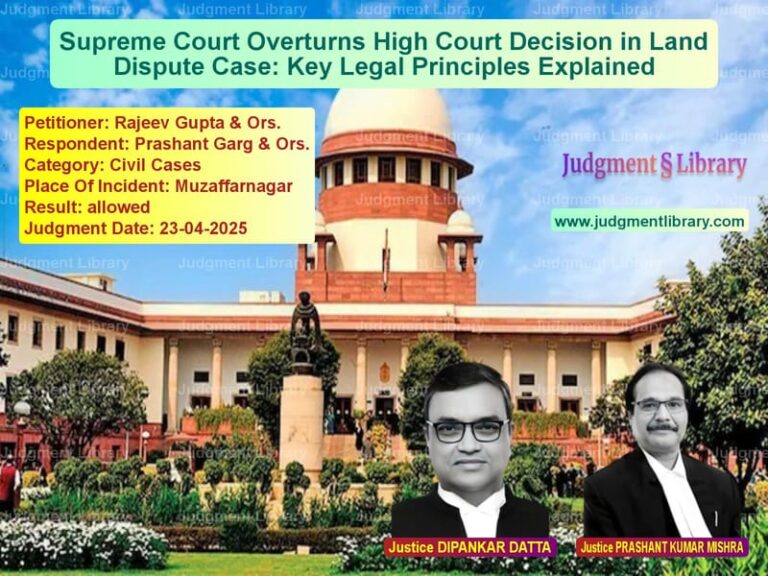Supreme Court Clarifies Stamp Duty on Mortgage Deeds vs Security Bonds in Landmark Ruling
In a significant judgment that clarifies the often-confusing distinction between mortgage deeds and security bonds for stamp duty purposes, the Supreme Court of India has delivered a comprehensive ruling that will have far-reaching implications for property transactions and loan agreements across the country. The case, decided on October 8, 2025, involved two separate appeals that raised identical legal questions about the proper classification of documents labeled as ‘Security Bond cum Mortgage Deed’ under the Indian Stamp Act.
The legal battle began when M/s Godwin Construction Pvt. Ltd. executed a ‘Security Bond cum Mortgage Deed’ with the Meerut Development Authority on December 19, 2006. The company had been granted permission to develop a colony called ‘Global City’ in Abdullahpur, Meerut, and as part of the agreement, they mortgaged specific plots totaling 2,934.45 square meters to secure their obligations, including payment of external development charges. The company paid a stamp duty of only ₹100, claiming the document fell under Article 57 of Schedule 1-B of the Indian Stamp Act, which covers security bonds.
However, the Deputy Commissioner (Stamps) in Meerit took a different view. In 2008, he issued a notice to the company stating that the instrument was actually chargeable under Article 40, which deals with mortgage deeds, and demanded deficient stamp duty of ₹4,61,660 along with penalty and interest. This began a long legal journey that would eventually reach the Supreme Court.
The second case involved a similar situation where a company director executed a ‘Security Bond or Mortgage Deed’ with Allahabad Bank to secure a business loan of ₹1,66,00,000. Again, the stamp authorities determined that the document was a mortgage deed chargeable under Article 40 rather than a security bond under Article 57.
Both matters eventually reached the Supreme Court, where a bench comprising Justices Ahsanuddin Amanullah and Prashant Kumar Mishra heard the arguments and delivered a judgment that provides much-needed clarity on this technical but important aspect of stamp duty law.
The Legal Arguments
The appellants’ counsel made a straightforward argument: ‘Learned counsel for the appellants in both the Appeals submit that the instrument executed by the appellants should be charged for stamp duty as per Article 57 of Schedule 1-B of the Indian Stamp Act. Learned counsel further asserted that the subject deeds are not simplicitor mortgage deeds as defined under Section 2(17) of the Indian Stamp Act, 1899. Hence, the stamp duty cannot be levied under Article 40 of the Indian Stamp Act, 1899.’
On the other side, the respondents’ counsel maintained their position that the lower authorities had correctly classified the documents: ‘Per contra, the learned counsel for the respondents contended that the impugned orders have rightly held that the deeds executed by the appellants in favour of the Meerut Development Authority and the Allahabad Bank respectively are chargeable under Article 40 of Schedule 1-B of the Indian Stamp Act, 1899. Learned counsel assert that the orders of the High Court do not require any interference.’
The Court’s Analysis
The Supreme Court began its analysis by establishing a fundamental principle of stamp duty law: ‘It is trite that, in matters of stamp duty, the decisive factor is not the nomenclature assigned to the instrument, but the substance of rights and obligations it embodies. The Court is duty-bound to ascertain the true legal character of the instrument.’
This principle would become the cornerstone of the entire judgment. The Court emphasized that what matters is not what a document is called, but what it actually does and what rights and obligations it creates.
The Court then examined the specific provisions of the ‘Security Bond cum Mortgage Deed’ executed by Godwin Construction. After quoting extensively from the document, the Court noted that the appellant had ‘transferred all their interest in the properties detailed in the schedule to the Meerut Development Authority. The transfer was made with the intent that the same shall remain charged by way of mortgage to secure due performance of obligations in developing the colony and payment of external development charges.’
The instrument further stipulated that in case of default, the Meerut Development Authority would be entitled to sell the mortgaged properties to realize the amount. This, the Court found, perfectly matched the definition of a mortgage deed under Section 2(17) of the Indian Stamp Act, which defines a mortgage deed as ‘every instrument whereby, for the purpose of securing money advanced, or to be advanced, by way of loan, or an existing or future debt, or the performance of an engagement, one person transfers, or creates, to, or in favour of, another, a right over or in respect of specified property.’
The Court made a crucial observation: ‘When juxtaposed with Section 2(17) of the Indian Stamp Act, it is evident that the instrument executed by the appellant fulfils the essential characteristics of a mortgage deed. In substance and effect, the deed confers a right over specified properties in favour of the Meerut Development Authority to secure performance of an obligation, while preserving the appellant’s interest until full discharge of obligation. The nomenclature ‘Security Bond cum Mortgage Deed’ is, therefore, inconsequential, as it is the substance and operative provisions of the instrument which govern its character for the purposes of stamp duty.’
The Critical Distinction Between Articles 40 and 57
The Court then turned to the heart of the matter – the distinction between Article 40 (mortgage deeds) and Article 57 (security bonds) of Schedule 1-B of the Indian Stamp Act. The Court noted that Article 57 operates in two distinct limbs. The first covers security bonds executed for the due execution of an office or to account for money received by virtue thereof. The second limb, which was relevant to this case, covers instruments ‘executed by a surety to secure the due performance of a contract.’
The Court’s interpretation of this second limb proved decisive: ‘The second limb, demarcated by the words ‘or executed by a surety to secure the due performance of a contract’, is restricted in its application to the execution of security bond or mortgage deed by a surety to secure the obligations of another, and does not extend to cases where the principal itself executes the deed to secure its own obligations.’
This interpretation was based on the definition of ‘surety’ under the Indian Contract Act. The Court explained: ‘The term ‘surety’ must be strictly understood in accordance with Section 126 of the Indian Contract Act, 1872… It follows that a contract of guarantee is inherently tripartite, consisting of the surety, principal debtor, and a creditor. Consequently, the essential requirement for invoking Article 57 is the presence of a surety distinct from the principal debtor. Where the principal debtor itself executes a deed mortgaging its own property, Article 57 is inapplicable.’
Applying this principle to the facts, the Court found that in both cases, there was no third party acting as surety. The companies themselves were mortgaging their own properties to secure their own obligations. In the Godwin Construction case, the Court observed: ‘It stands beyond doubt, that the deed was not executed by a surety but by the principal debtor/appellant, the company, through its director. It is evident that the company itself mortgaged the properties and not the director in his individual capacity. A company, though a juristic person, is not a sentient being, consequently, it must act through its directors. This firmly establishes that the properties were not mortgaged by a third party, but by the principal debtor itself, which, in our opinion, does not attract Article 57.’
The Court reached the same conclusion in the second case involving the loan from Allahabad Bank: ‘In the present case, although clause III of the deed stipulates that the mortgagor shall be personally liable to repay the loan, a careful reading of the deed makes it manifestly clear that Shri Naveen Mittal executed the deed solely in his capacity as the director of the company M/s Ajay Forging Pvt. Ltd, acting on behalf of the company. No distinct surety exists apart from the principal debtor. Accordingly, reference to personal liability in the deed pertains to the director acting on behalf of the company and does not transform the instrument into a security bond under Article 57 of Schedule 1-B of the Indian Stamp Act, 1899.’
The Final Ruling
After this detailed analysis, the Supreme Court concluded that both instruments were properly classified as mortgage deeds chargeable under Article 40 rather than security bonds under Article 57. The Court dismissed both appeals, upholding the decisions of the lower authorities and the High Court.
The Court summarized its final position: ‘In our opinion, the impugned judgments passed by the High Court of Judicature at Allahabad do not suffer from any infirmity as to warrant interference by this Court. The Appeals are, accordingly, dismissed.’
This judgment serves as an important reminder that in stamp duty matters, substance always prevails over form. The name given to a document by the parties cannot determine its legal character for stamp duty purposes. What matters is the actual rights and obligations created by the instrument. The ruling also provides clear guidance on the essential distinction between mortgage deeds and security bonds – the presence of a third-party surety is necessary for a document to qualify as a security bond under Article 57. When a principal debtor mortgages its own property to secure its own obligations, the document will always be treated as a mortgage deed under Article 40, regardless of what label the parties choose to give it.
The implications of this judgment are significant for businesses, banks, and development authorities across India. It provides much-needed clarity on a technical but important aspect of property and loan documentation, ensuring that stamp duty is properly calculated based on the true nature of transactions rather than creative labeling by the parties involved.
Petitioner Name: M/S Godwin Construction Pvt. Ltd..Respondent Name: Commissioner, Meerut Division & Anr..Judgment By: Justice Prashant Kumar Mishra, Justice Ahsanuddin Amanullah.Place Of Incident: Meerut, Uttar Pradesh.Judgment Date: 08-10-2025.Result: dismissed.
Don’t miss out on the full details! Download the complete judgment in PDF format below and gain valuable insights instantly!
Download Judgment: ms-godwin-construct-vs-commissioner,-meerut-supreme-court-of-india-judgment-dated-08-10-2025.pdf
Directly Download Judgment: Directly download this Judgment
See all petitions in Judgment by Prashant Kumar Mishra
See all petitions in Judgment by Ahsanuddin Amanullah
See all petitions in dismissed
See all petitions in supreme court of India judgments October 2025
See all petitions in 2025 judgments
See all posts in Taxation and Financial Cases Category
See all allowed petitions in Taxation and Financial Cases Category
See all Dismissed petitions in Taxation and Financial Cases Category
See all partially allowed petitions in Taxation and Financial Cases Category







